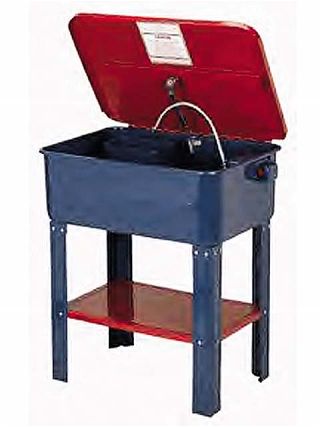 | Chicago Electric 20-gallon Parts Washer
| Chicago Electric 20-gallon Parts Washer
There are people in this world who do not care about dirt. I do not like these people. Their engine compartments are untidy, and their work tends to be the same way. Even backing off this extreme, some jobs just require parts cleaning. I recommend an inexpensive parts washer from Chicago Electric. Now, let's get something clear: This unit is not top of the line. In fact, despite the company's robust name, this parts washer is made in China just like nearly everything else. There's no reason to spend more than a hundred bucks on one of these things for the garage out back or under your house, and we've found one that's only $70.
A really nice parts washer, like those of Safety-Kleen Systems, can swallow a massive Getrag gearbox from a decrepit Mercedes 190 with room left for the flywheel. Unfortunately, Safety-Kleen sells a "service" that includes periodic visits to renew the parts washer fluid and properly dispose of the old stuff. Clearly, this is not the ticket for the average home shop. While you won't fit a gearbox in the Chicago Electric 20-gal. Parts Washer, it'll do a fine job on almost everything else. It'll even take a BMW 2002 differential.
For the price, the Chicago Electric 20-gal. Parts Washer is fairly rugged, constructed of welded steel. It has an electric pump that circulates a claimed 50 gal. of solvent per hour. The steel stand has a storage shelf, built-in drain, small parts basket and chrome-steel flexible spigot. A self-latching cover includes a safety feature that closes the cover in case of fire. Inside tank dimensions are 28 1/2W x 19-1/4L x 10-5/16D. Some assembly is required, but the tank itself is fully constructed.
My testing revealed that it is a good idea to mount the legs on small wooden blocks if you live in the rust belt; mine rusted by resting on the concrete floor. Also, the pump switch failed after about a year of use. Five bucks at Radio Shack yielded a suitable replacement. Once you get a parts washer set up, you are confronted with what to put in it for solvent. "What with the environment and all, it's getting hard to find good parts cleaning solvent unless you buy into Safety-Kleen," said the guy at my local mom-and-pop auto parts store here in Dingledorf, Penn. He sold me a product called Gunk SC-3 Degreaser Concentrate, which on his recommendation I mixed with 5 gal. of kerosene. It works fine, as Gunk SC-3 is approved by its manufacturer for mixing with kerosene. The auto store, which handles waste oil disposal, will take the solvent when it comes time to renew it.
Now, obviously, the Gunk SC-3 with kerosene mixture is flammable as would be any parts cleaning solvent, so here is the obligatory warning, Mikey style: If you have a common sense deficit and/or tend to be a victim of your own idiocy, you should not be working on cars at all let alone using parts cleaning solvent. It is nice that you like European cars; we do, too, but when a car needs work, most people need to take it to a professional technician. You know who you are.
Neither this publication nor I will be responsible for the results of your own folly, both of us firmly convinced that it should be viewed as part of God's Great Plan. To avoid leaving us as part of His Plan, keep flame and other sources of ignition away from the parts cleaning solvent and close the cover when the unit is not in use.
Another hint: Place a work light of some sort over the parts washer. I installed a cheap porcelain light fixture on the ceiling over mine, with a 100w outdoor spotlight bulb pointing right into the tank.
I bought a Chicago Electric 20-gallon Parts Washer from HarborFreight.com for $70. It is item 7340-2VGA.
